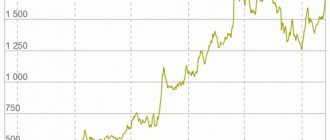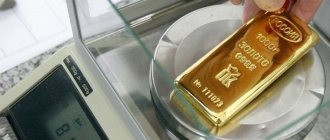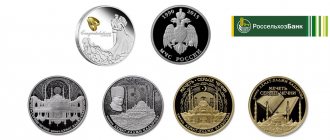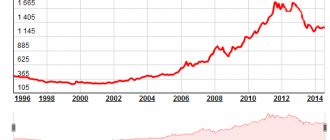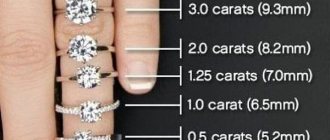1 troy ounce of gold is a measure of the weight of precious metals
| This page or section contains special Unicode characters. If you do not have the required fonts , some characters may not display correctly. |
Ounce
(lat. uncia) is the name of several units of measurement of mass, as well as two measures of volume of liquid bodies, one unit of measurement of force and several monetary units formed as a twelfth of another unit.
The term comes from ancient Rome. It was one of the main weight units of medieval Europe. Today it is used when trading precious metals - the troy ounce, as well as in countries where weight is measured in pounds (for example, the USA).
In the dictionary Dictionary of foreign words
and, f.
1. A unit of pharmaceutical weight equal to 29.8 g. | The size of one ounce is not the same in different national traditions: in the English system of measures 1 cu. = 28.350g, Russian price. equaled 29.860g; u. as a measure of volume in the USA it is 29.57 cm2; in England 28.41 cm2; in a number of Latin American countries. used as a unit of mass, on average close to 28.7g.||Avg. GRAN" title='GRAN, GRAN this, what is GRAN, GRAN interpretation'>GRAN, SCRUPULE" title='SCRUPULE, SCRUPULE this, what is SCRUPULE, SCRUPUL interpretation'>SCRUPULE.
2. Antique Spanish, Italian, Mexican, Argentine, Bolivian gold and Moroccan silver coin.
Share the meaning of the word:
Troy ounce
The troy ounce is a generally accepted measure for precious metals.
Simplified value for translation: 1 ozt – 31.1035 grams .
It should be noted that in international trade this unit is used only to determine the mass of pure metals of the highest standard.
On world currency markets, the XAU index is used to indicate the rate of 999.9 gold. Mints in different countries mint coins weighing 31.1 g. Many, both old and modern money made of gold and silver, have this denomination.
Ounce and metric units
Ounce as a measure of weight
- An ounce of avoirdupois
(abbreviation
oz
or
oz at
) - in the USA and a number of other countries is 1/16 of the basic unit of mass - a pound of avoirdupois (equal to 453.59237 g). The weight of an ounce of avoirdupois is 28.35 g (28.349 523 125 )[2]. - Troy ounce
(abbreviation
t oz
or
ozt
) - 31.1034768 g. Used in banking and jewelry to measure the weight of precious metals. The term comes from the troy weight system, which was widely used in Europe until the introduction of the metric system of measures. Unlike the avoirdupois pound, the troy pound consisted of 12 ounces. In different countries, the weight of a troy ounce was slightly different. From 1824 to 1858, the troy pound was the main unit of weight in Great Britain. It is the weight of the British troy ounce that is used when trading precious metals[3]. - Pharmaceutical ounce
(
℥
) is an obsolete term.
In many countries, in addition to the civil or commercial weight system, pharmacists used apothecary weight
. Pharmacist's weight standards varied from country to country. The ounce was the basic unit of pharmaceutical weight and its weight in different cities and countries ranged from 25 to 35 grams. - In the Netherlands, when switching to the metric system of measures in 1820, an ounce (Dutch ons) began to mean 100 [4].
Ounce as a measure of volume
- Fluid ounce
(abbreviation
fl oz
) (American) - has a volume of 29,573,531.
Constitutes 1/16 of a US liquid
pint (which is approximately 0.47 liters). In the US, for food labeling purposes only, a fluid ounce is equivalent to 30 ml. - Fluid ounce
(abbreviation
fl oz
) (English) - has a volume of 28,413,063 ml[5]. Constitutes 1/20 of an English pint (equal to 0.56826127 liters).
Using recalculation in practice
The need to convert ounce to gram arises, in most cases, when trying to calculate how much gold or silver costs per gram in national currency, for example in rubles, today. The calculation algorithm is quite complex and requires knowledge not only of the cost of the metal in dollars per ounce, but also of the ruble/dollar exchange rate. It looks like this:
the cost of gold (USD/ozt) divided by 31.1035 and multiplied by the exchange rate USD/RUB, we get the price of gold in RUB/g.
There is a calculator for calculating the cost of gold, which makes calculations based on data from the Central Bank, which makes it much easier and faster to get the desired result.
You can find a large number of unit converters on the Internet; when using such programs to convert the weight of precious metals, it is important to remember that you need a troy ounce, and not some other unit.
I hope this article helped to understand the question: 1 ounce, how many grams. Also, when determining value in jewelry, questions often arise related to another obscure unit for determining mass - the carat. You can read the article about this: 1 carat, how many grams.
Content
- 1 Etymology
- 2 Definitions 2.1 Currently in use 2.1.1 International avoirdupois ounce
- 2.1.2 International troy ounce
- 2.1.3 Metric ounces
- 2.2.1 Apothecary's ounce
- 5.1 Fabric weight
Notes and links
- uncia. Charlton T. Lewis and Charles Short. Latin dictionary
for the Perseus Project. - "ounce". Oxford English Dictionary
(Online ed.). Oxford University Press. (Subscription or membership of a participating institution is required.) - “Units of Measurement Regulations 1995 (Article 4).” 2000-09-20. Retrieved 2009-01-26.
- London Bullion Market Association. "Market Fundamentals". Archived from the original on 2012-03-08.
- Wittop Koning, D. A.; Huben, G. M. M. (1980). 2000 jaar gewichten in de nederlanden
(in Dutch). Lochem-Poperinge: De Tijdstroom. ISBN 9060879651. (in Dutch) - "Guide to The Hague - Where to go." Archived from the original on 2008-03-16. Retrieved 2008-01-01.
- nl: Nederlands metriek stelsel
- Onts at KBBI
- Greenfield, Richard (1965). Ethiopia: A New Political History
. F. A. Praeger. paragraph 327. - Observer for Ethiopia
.
6
. 1962. pp. 187–8. - Diccionario de la Real Academia Española
, 23rd edition, Libra - Diccionario de la Real Academia Española
, 23rd edition, onza - Robert Slater, An Inquiry into the Principles of the Decimal Representation of Weights, Measures and Currency of the United Kingdom
(London: Arthur Hall, 1855), 11.books.google.com/books?id=nctVAAAAcAAJ&pg=PA11&lpg=PA11 - “How to shop at a fabric market.” Retrieved 2008-12-10.
- "Frequently Asked Questions About Copper Thickness." Retrieved 2016-11-13.
Various ounces
Historically, in different parts of the world, at different times and for different uses, the ounce has been used to refer to similar but slightly different standards of mass.
Weight ounces
| Option | (grams) | (grains) |
| International heavyweight ounce | 28,349523125 | 437,5 |
| International troy ounce | 31,1034768 | 480 |
| Apothecary's ounce | ||
| Ounce of Maria Teresa | 28,0668 | |
| Spanish ounce ( onza ) | 28,75 | |
| French ounce ( once ) | 30,59 | |
| Portuguese ounce ( onça ) | 28,69 | |
| Roman/Italian ounce ( oncia ) | 27,4 | |
| Ancient Roman ounce | 28,34 | |
| Dutch metric ounce ( ons ) | 100 | |
| Dutch (premetric) ounce ( ons ) | 30 | |
| Chinese metric ounce (盎司) | 50 | |
| English tower ounce | 29,1595095 | 450 |
Notes
- ↑ 123
Ounce // Encyclopedic Dictionary of Brockhaus and Efron: in 86 volumes (82 volumes and 4 additional). - St. Petersburg, 1890-1907. - Russ Rowlett.
How Many? A Dictionary of Units of Measurement (English). University of North Carolina at Chapel Hill. Access date: October 8, 2010. Archived August 22, 2011. - What is a Troy Ounce? (English). Access date: October 8, 2010. Archived August 22, 2011.
- Guide to The Hague - Where to turn (English). Access date: October 8, 2010. Archived February 19, 2007.
- Russ Rowlett.
How Many? A Dictionary of Units of Measurement (English). University of North Carolina at Chapel Hill. Access date: October 8, 2010. Archived August 22, 2011.
Other uses
Fabric weight
Ounces are also used to refer to the "weight", or more accurately the area density, of textile fabric in North America, Asia or the UK, as in " 16 ounce denim"
". The number refers to the weight in ounces of a given amount of fabric, whether it be a yard of a given width or a square yard, where the depth of the fabric is a constant depending on the fabric.[14]
| Fabric type | Typical weight in ounces |
| Organza, veil, chiffon | 1–3 |
| Most cotton, wool, silk, muslin, linen | 4–7 |
| Denim, corduroy, twill, velvet | 7–16 |
PCB copper layer thickness
The most common unit of measurement for copper thickness on a printed circuit board (PCB) is ounces (oz), as in mass. This is the resulting thickness when the copper mass is flattened and evenly distributed over an area of one square foot. 1 ounce is approximately 34.7 microns.[15]
Ancient Rome
For the ancient Romans, an ounce was 1/12 of something. For example, an ounce, as 1/12 of a unit of weight called libra (lat. libra) or ass and weighing 327.45 g (0.7996 Russian pounds or 76 spools 73 shares), and corresponded to 28.34 g (0.0666 Russian lbs or 6.394 spools). In turn, the ounce was divided into 2 semuntia, 4 sicilicus, 6 sextouli, 24 scrupules and 144 siliqua. The ounce was designated by a dot ( ·
) or (on coins) in the form of a small convex hemisphere, sometimes with a horizontal line (
-
), and also (in cursive) with the signs and;
½ ounce (semuntia) was designated by the signs Σ
,
Є
,
£
, sicilics -
Ɔ
, sextules -

